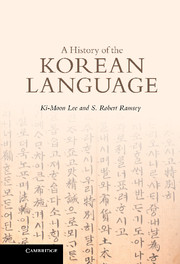Book contents
7 - Contemporary Korean
Published online by Cambridge University Press: 05 June 2012
Summary
The story of Contemporary Korean begins with Korea's fitful emergence on the world stage in the late nineteenth century. The opening of Korean ports to outside powers brought sweeping political and social change to the country, and the pace and pressure only intensified over the next half-century. For the most part, the change was traumatic. The history of the Japanese colonial period, the partition of the country into north and south, and the culminating, internecine Korean War, was grim.
But the history of the language that played out against this backdrop was not altogether a story of misfortune. The reform of the language, particularly in how it was written, was very much at the center of what in Korea is called the “enlightenment period.” The stage for that movement was set in the early nineteenth century, when there developed out of the Sirhak (Practical Learning) tradition a body of scholarship, known as “enlightenment thought,” that argued for the opening of Korea to Western culture and technology. Then, when Korean ports were forcibly opened to foreign commerce with the Kanghwa Treaty of 1875, many of those Korean intellectuals looked toward constructing policies of reform and modernization. Thus began the “enlightenment period.”
At the top of the reformers' agenda was language. The creation of a modern state required a modern standard language for the proper functioning of society and government.
- Type
- Chapter
- Information
- A History of the Korean Language , pp. 287 - 305Publisher: Cambridge University PressPrint publication year: 2011

